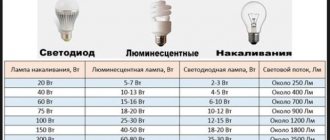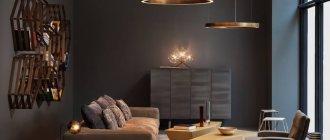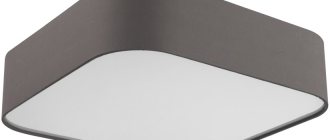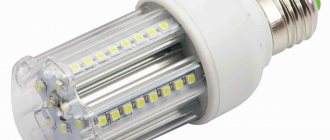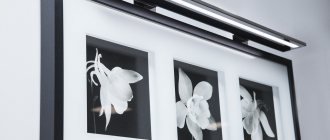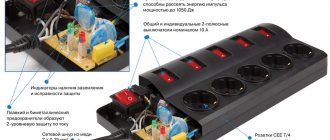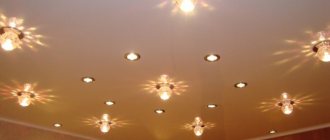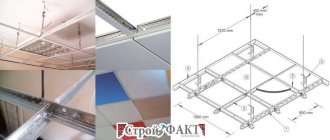The Armstrong suspension system is a practical, inexpensive and stylish option for finishing the ceiling, actively used in public and commercial buildings. A wide range of textures and colors allows you to give the top floor an original look, and the functional design provides excellent opportunities for individual lighting design. Finding the right lamp for Armstrong is extremely easy! Various types of lighting fixtures can be integrated into this ceiling system. You just need to choose the right lamps and understand the features of their installation.
Armstrong ceilings and their features
This type of ceiling system has a characteristic and recognizable appearance - a flat surface divided into squares. The basis of the structure is a metal frame. It consists of various profiles that are connected to each other with special latches and attached to the ceiling using hangers.
The main feature of the Armstrong ceiling is its square cells of standard size 600x600 mm. They are filled with lightweight mineral fiber-based slabs. The panels lie on a metal profile, supported only by their own weight. This allows you to quickly dismantle them - for example, to install a lamp or to gain access to communications.
Positive and negative sides
A ceiling lamp of this type has its advantages, including:
- Simple installation that can be carried out on any part of the ceiling. This makes it possible to make lighting effective and precisely in the required areas.
- Easy access to fasteners and wiring.
- Ease of replacing damaged elements and burnt out lamps.
- High light transmission efficiency.
- Possibility to use different types of lamps: LED or fluorescent. Both the first and second options will be economical.
- If the need for local lighting is no longer necessary, then you can replace the block with lamps with a ceiling panel. Moreover, it will be completely unnoticeable.
An original solution using LEDs.
There are also disadvantages, including the following:
- No matter how their design changes, the appearance of Armstrong lamps remains standard, so they definitely will not be a decorative element.
- Another drawback comes from trying to decorate them. For this purpose, opal diffusers are used, which quickly lose their brightness and have to be replaced.
- The cold light spectrum of lamps can be tiring.
Types of LED ceiling lights Armstrong
To organize lighting in rooms with hanging systems of this type, various lighting devices are used. The classic solution is Armstrong ceiling lamps, which are designed specifically for installation in suspended ceilings. They have a square shape and standard dimensions (600x600 mm). There are elongated or shortened models. Also, for installation on Armstrong ceilings, spotlights are actively used - single and double, fixed and rotating.
Based on the method of integration into the suspension system, lighting devices are divided into two categories:
- Built-in. The lamps are mounted inside the cell. Their body is recessed inside to a depth of 20 cm, and only the diffuser remains visible from above. This type of lamps allows you to create smooth ceilings without protruding elements.
- Invoices. They are mounted on top of the plates installed in the cell or in their place with a small protrusion. Surface-mounted luminaires diffuse light better and exhibit higher brightness. The only drawback is the body protruding above the ceiling line.
Point design
Armstrong spotlights have a distinctive design, which is represented by a cylinder embedded in the ceiling tile.
According to their design, point ones can be divided into:
- double;
- triple;
- rotary.
Advantages of lamps for Armstrong
Modern lighting technology, created for integration into suspended ceiling systems of this type, has a huge number of advantages.
The main advantages of Armstrong lamps are:
- quick installation by replacing one ceiling slab with a lamp;
- universal design that goes well with any interior;
- light weight of the device and easy to maintain design;
- absolute silent operation and no overheating;
- bright and even light output with uniform dispersion;
- affordable price compared to other models;
- wide selection of front panels (different shades and textures).
Many lighting design experts believe that Armstrong lamps are the best choice for lighting large spaces. In addition, the light they emit is the most comfortable for long-term work.
Fluorescent lamp device
Although fluorescent lamps are ubiquitous today, their design remains quite complex. Such a lamp will not work directly from the electrical network, as incandescent lamps do. In order to start the process of transformation of ultraviolet radiation, which occurs in the gaseous environment of a fluorescent lamp, certain conditions are needed. They can be created using a special device - ballast. It is also called ballast. Today, fluorescent lamps used in Armstrong luminaires use connection circuits with electromagnetic (abbreviated as EMBA) or electronic ballast (abbreviated as EPGB). The latest version of the ballast is more modern and allows you to reduce the electrical energy consumption of a fluorescent lamp by 20-25 percent compared to lamps operating in conjunction with electric ballasts.
Design of a lamp for a suspended ceiling Armstrong
Almost the entire line of lighting devices for ceiling systems of this type has a similar design. The lamps have a metal body made of light aluminum alloy. Depending on the dimensions of the model, its weight can vary from 0.5 to 3-4 kg. Inside the case there are light sources (LED strips, fluorescent lamps), batteries (wires, starting equipment, transformer unit), reflectors and other components.
The main element of any lamp is the diffuser. The simplest option is open mirror grilles. However, they are only appropriate in public areas. For commercial and other facilities, lamps with plexiglass or plastic diffusers are used. Such panels hide the internal structure of the device, contribute to the correct distribution of the light flux and soften its intensity.
Diffusers come in three main types:
- “Opal” is a homogeneous matte sheet with a light transmittance of 80%;
- “Prism” - with a fine-grained texture and light transmission of 90%;
- “Cracked ice” - with a relief texture that transmits about 85% of light.
The degree of protection of the housing from the external environment varies. For rooms with a normal microclimate, models with IP20-IP40 are offered. For objects with aggressive environments, Armstrong lamps with protection IP54 and higher are used.
Lighting devices of this type can additionally be equipped with a battery. It plays the role of an emergency power supply unit (EPU), providing light sources with energy in the event of a power outage through the central network.
What do we offer
Our company presents LED devices for Armstrong type ceilings with cells of various sizes - 600x600 mm (the most popular option), 600x1200 mm, 300x1200 mm, 300x600 mm. From us you can buy equipment for integrated and surface-mounted installation, as well as universal devices.
The assortment includes lighting fixtures of different power and types of acrylic diffusers (opal, prism and microprism, crushed ice).
The equipment also differs by manufacturer. You can choose expensive Premium-class devices with excellent quality diodes, a high level of color rendering, and a long service life, which are offered by Nishi, Philips, and OSRAM. Or purchase inexpensive Chinese devices that also work well, but their service life is somewhat shorter.
Application
Armstrong lamps can be found wherever suspended ceiling systems of the same name are installed. The main area is shopping centers, shops and boutiques. Also, this line of lighting devices is actively used at the following facilities:
- office and administrative premises;
- hotel complexes;
- restaurants, fast foods and cafes;
- sports centers and gyms;
- warehouse and technical premises;
- industrial workshops and workshops;
- medical and educational institutions.
Armstrong ceiling lamps are usually installed in rows along the windows, which allows you to create an imitation of daylight in the evening. Another popular solution is to install lighting fixtures in a checkerboard pattern. This option allows you to achieve the most uniform dispersion of light over the entire area.
Features of lighting fixtures
Armstrong lamps are the general name of lighting devices intended for ceiling suspension systems such as Grilyato, Armstrong, and plasterboard structures.
Devices can be integrated or overhead. The first option is recessed (replaces tiles) into the ceiling and forms a single flat surface with it. Overhead devices provide greater light output, but are not as ergonomic.
The equipment is a metal frame in which light sources with a power of 32 to 50 W are fixed. Ceiling cells have a standard size of 600x600 mm, so the devices are produced with dimensions of 595x595 mm for implementation. When installing in an overhead manner, you do not have to remove the plate, but simply fix the device on top of the element.
For every 4 sq. m of room area requires one lighting fixture.
Comparison of LED and fluorescent lamps under Armstrong
Lighting devices for suspended ceilings on the market operate primarily on two types of lamps. The first option is T8 fluorescent, and the second is the increasingly popular LEDs. Both types have advantages and disadvantages. To make it easier to choose a lamp for an Armstrong suspended ceiling, we suggest comparing these models:
- Resource. Fluorescent devices operate for approximately 8,000 hours. LED lamps significantly surpass them in this indicator - about 50,000 hours. These are figures guaranteed by the manufacturer, often confirmed in practice.
- Durability. Flickering and a decrease in brightness by more than 60% are inevitable consequences of active use of a fluorescent lamp. LEDs, even after 5-8 years of operation, retain up to 75% of their original brightness.
- Energy efficiency. LED lamps are the most economical. They do not require long heating and consume little energy. Compared to fluorescent analogues, such lamps consume 2.5-3 times less energy.
- Resistant to voltage surges. Fluorescent lamps are very demanding on the quality and stability of the current. Their LED analogues can easily withstand voltage surges of up to 1000 Volts, after which they continue to work in standard mode.
- Light output. The maximum luminous flux power of fluorescent lamps is 70 Lm. And the higher the indicator, the more energy is consumed. LED lamps surpass them in light output - more than 120 Lm per Watt.
- Pulsation of light. An important parameter for objects where constant visual control over equipment and devices is important. The ripple of fluorescent devices reaches 15%, and of LED devices - no more than 4%.
- Lighting comfort. Fluorescent lamps produce a harsh, cold stream of light that can quickly tire the eyes. LED lamps offer a wider range of glow: from warm soft to neutral daylight.
- Environmental friendliness. LED lamps are safe for humans and the environment. They do not contain toxic vapors or other toxic substances that pose a threat if the flask breaks.
As you can see, LED lamps for Armstrong pendant systems are the preferred choice in many respects. Such lighting fixtures will allow you to organize room lighting to high standards, making the design of the ceiling spectacular and practical.
Comparative analysis of main characteristics
The choice of lamps is made by comparing their performance qualities. Let's look at the characteristics of both types:
Energy consumption
This value shows how much energy is spent to achieve the same result. Here the leaders are LED lamps, the installation of which in the Armstrong ceiling allows saving 50% of energy from the consumption of fluorescent devices.
Uniformity and light intensity
Fluorescent devices have an unpleasant property - they flicker, which is especially noticeable when the voltage drops in the network. LED lamps for Armstrong do not have this drawback; they produce an even, bright light that does not depend on voltage fluctuations or surges. In terms of luminous intensity (illuminance), LED devices are also ahead.
Life time
Manufacturers claim that the service life of LED devices is 4-5 times higher than that of fluorescent devices. Practice confirms this statement. Installing Armstrong LED lamps allows you to solve the problem for a long time, while older devices fail much more often.
The easiest way to compare the parameters of LED and fluorescent devices is to use a table that displays the characteristics of both devices:
The advantages of Armstrong LED lamps over fluorescent lamps are obvious, but in practice the number of both devices is almost the same. This is explained by the cost of the devices and the reluctance of owners to replace old lamps with new models.
